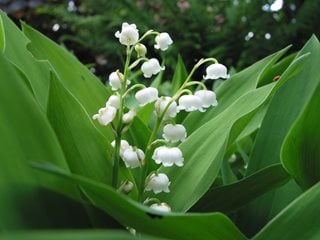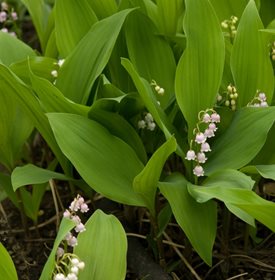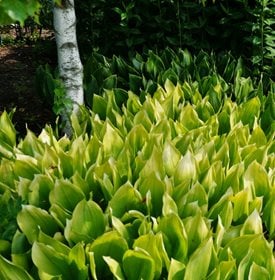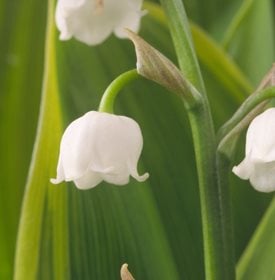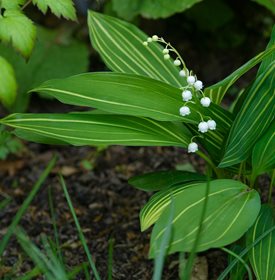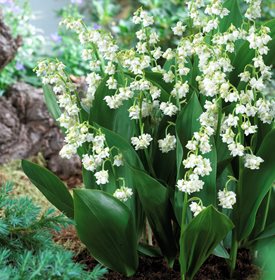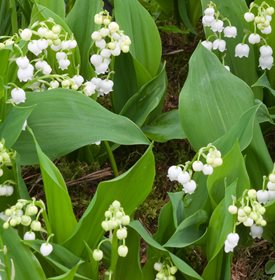Lily-of-the-Valley Revisited
Fall in love all over again with this fragrant white-flowering perennial. Newer cultivars are less intrusive and bring more color and variety to the woodland garden.Of all the plants growing in my tree-shaded backyard, lily-of-the-valley is the one I delight in the most. It kindles fond childhood memories of strolling through my grandmother’s garden, where I first beheld those enchanting white flowers hanging like fairy bells above the emerald-green foliage. And the fragrance! To this day, I still can’t wait for that intoxicating scent to fill the spring air with its sweet perfume, which is reason alone to grow this resilient flowering groundcover.
Although its charms are many, lily-of-the-valley is a plucky little plant with a penchant for wanderlust. If you don’t have room to let it spread to its heart’s content, there are a number of lovely cultivars that are not only less assertive but also more ornate, with variegated foliage and larger, more abundant blooms. With such a diversity of options, almost any gardener with a patch of shade can discover new ways to enjoy this old-fashioned favorite.
On this page: Lily-of-the-Valley Basics | Growing Tips | Good Companions | Lily-of-the-Valley Types | Sources for Lily-of-the-Valley
- LILY-OF-THE-VALLEY BASICS
- GROWING TIPS
- LILY OF THE VALLEY TYPES
- GOOD COMPANIONS
- SOURCES FOR LILY-OF-THE-VALLEY
LILY-OF-THE-VALLEY BASICS
Lily-of-the-valley (Convallaria majalis) gets its botanical name from the Latin words for "the valley" (convallis) and "belonging to May" (majalis). Despite the name, it’s not a lily or even in the lily family. It’s actually a member of the Asparagaceae (which includes asparagus) and belongs to the subfamily Nolinoideae, which it shares with other spreading groundcovers such as lilyturf (Liriope) and Solomon’s seal (Polygonatum).
Zones:
Grow in zones 2 to 7. This ultra-hardy perennial actually prefers cold weather, which encourages better flowering in the spring. Although it will tolerate the warmer weather of zones 6 and 7, it struggles in zones 8 and above.
Exposure:
Grow in full or partial shade. It does not like a situation that is too sunny or too hot or dry.
Bloom time:
Established plants will bloom in mid to late spring.
Height:
6 to 18 inches
Lily-of-the-valley spreads by fast-creeping rhizomes that travel just under the soil surface. Where they take root, small conical offshoots called “pips” form that sprout the leaf-bearing stems and racemes of petite, scalloped-edged bells.
Although lily-of-the-valley is widely grown in North America, it enjoys cult-like status in Europe, where it’s considered one of the main harbingers of spring and is called the mayflower as a symbol for the month of May (inspiring the name of the boat the Pilgrims sailed from England to the New World in 1620). Lily-of-the-valley is also a favorite flower in the bouquets of royal brides, including Queen Victoria, Princess Astrid of Sweden, Grace Kelly, and Kate Middleton. Iconic British rock band Queen even has a song named after the plant.
Pros:
- Will thrive and bloom in heavy shade, even under deciduous trees and shrubs and along north-facing walls.
- Will tolerate all soil types including acidic, clay, loamy and sandy soils.
- The captivating flowers last for several weeks, followed by glossy red berries in the fall.
- Naturalizes readily, creating a dense, low-maintenance groundcover that few weeds can infiltrate. Can also be used on slopes to control erosion.
- No pruning or winter care needed.
- Deer and rabbit resistant.
Cons:
- Be prepared to divide plants frequently (every two to three years) to contain their spread and prevent them from crowding out other desirable plants.
(See where lily-of-the-valley can be invasive.) - Does not grow well in full sun and hot, dry conditions, which can cause the leaves to turn brown and die back during the dog days of summer.
- May require a couple of years to establish before flowering.
- All parts of the plant, including the enticing red berries, are toxic if ingested. Take the appropriate precautions if you have pets or young children.
GROWING TIPS
Planting:
Plant the pips or divide existing plants in early spring or fall. Plant the pips about an inch below the soil line with the narrow tips pointing up and the roots facing downward, spacing them about 6 to 8 inches apart. Don’t worry if the plants seem sparse at first. They will fill in the gaps during the second growing season. Although lily-of-the-valley tolerates most soil types, it prefers moist, well-drained soil enriched with organic matter. At planting time, work in a few shovelfuls of humus or garden compost to help augment the soil. If you plant your pips in the fall, apply a light layer of mulch before the ground freezes to keep them from heaving out of the ground before they are well-rooted.
Watering:
Once established, lily-of-the-valley rarely needs supplemental watering because the dense foliage inhibits the evaporation of soil moisture. During periods of drought, a good soaking of the soil to keep it moist will help the foliage stay green and healthy all summer.
Dividing and transplanting:
Like many rhizomatous plants, lily-of-the-valley should be divided every few years to control its rapid spread and to keep the plants vigorous and blooming. Dig up and divide your plants when they are dormant (in early spring or fall) and gently separate and replant the pips. If you have a lot of plants that need to be removed or relocated, simply carve out large mats of roots with a spade and break them into smaller clumps.
Pests and diseases:
These tough, long-lived perennials are rarely bothered by pests or diseases. The most common ailments are fungal leaf spotting and crown rot. The best preventive measures are to thin out your lily-of-the-valley patches regularly to improve air circulation and to make sure the soil drains well. Also avoid using overhead sprinklers to water your plants.
Forcing indoors:
You don’t have to wait until spring to enjoy lily-of-the-valley’s heady fragrance. It’s easy to force the pips to flower indoors over the winter, much as you force spring bulbs. Dig them up in the fall after they’ve been exposed to a few hard frosts, and pot the pips with the thickest, healthiest roots, keeping the tips just below the soil surface. Place the pots in a bright location at room temperature and keep the soil evenly moist. In just a few weeks, they will begin to bloom. You can also pot lily-of-the-valley in the spring in the same manner to grow outdoors in containers. Watch this video from White Flower Farm to see the potting process.
LILY-OF-THE-VALLEY TYPES
GOOD COMPANIONS
Over time, just a few lily-of-the-valley plants will become a lush carpet of green that can easily stand alone as a groundcover. But if you prefer a bit of diversity, try combining lily-of-the-valley with other vigorous shade-tolerant plants that won’t mind its unbridled growth habit. Here are some ideas:
- Interplant lily-of-the-valley with periwinkle (Vinca minor) to create a lovely spring tapestry of lavender and white flowers.
- Use it as a carpet beneath azaleas and rhododendrons, which also bloom in midspring and like moist, woodsy soil conditions.
- Plant it with ferns, hostas, or variegated Solomon’s seal (Polygonatum odoratum var. pluriflorum 'Variegatum'), which will hide lily-of-the-valley’s foliage if it begins to turn drab later in the season.
- Co-mingle it with plants that provide a nice contrast in leaf structure and flower color such bleeding heart (Lamprocapnos), columbine (Aquilegia), hellebores, Grecian windflower (Anemone blanda), astilbe, hardy geraniums, and Siberian bugloss (Brunnera macrophylla ‘Silver Heart’).
RELATED:
20 Fragrant Flowering Plants
All-Star Spring Flowers for Your Garden
Snowdrops
